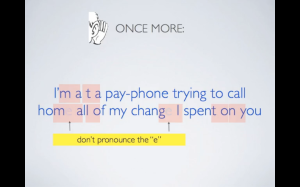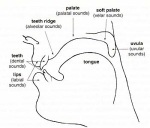Introductory note: I am now back in the United States, but I am continuing to write a few blog posts reflecting on my experience teaching English pronunciation to Iraqi schoolteachers this summer. My thoughts are still with these strong and resilient teachers, as many of their hometowns continue to be featured on the news for turmoil and armed conflict.

Screen shot of video from http://www.luizotaviobarros.com
As I was preparing for a lesson on connected speech, I came across one of the best pronunciation teaching videos that I have found online. The video, by Luiz Otávio, consists of a series of five short clips from pop music videos, each one lasting for 30 seconds or less, with features of connected speech highlighted for each one. The video itself is hosted here, and you can also read the creator’s introduction to the video on his blog here.
There are several features that make this video excellent for classroom use:
- It is efficient. The clips focus in on features of connected speech present in various songs, without taking up time with extended song lyrics that do not relate directly to the teaching point.
- It is repetitive—in a good way. Because each song clip is played several times, students have several opportunities to notice phenomena, and they receive reinforcement. I especially like that the last repetition of each song clip is slowed down, which makes it easier to hear the linking.
- It is inductive. Students hear the song clips before being told what points they illustrate. Information is also added gradually as the clip is repeated.
- It adds value. Most pronunciation videos, at least on YouTube, feature and instructor telling viewers about a language point, followed by some examples. This may be interesting enough for an independent learner at home, but it adds little to a classroom environment. By contrast, Luiz Otávio’s video consists almost entirely of authentic listening samples, with or without commentary. This content cannot otherwise be replicated by the teacher, unlike a taped lecture.
One teaching tip I would add for using the video well is to pause it when each set of song lyrics first appear to highlight which segments they should focus on. In this way, students engage with a specific listening goal and have the opportunity to compare their predictions to authentic materials.

Screen shot of video from http://www.luizotaviobarros.com
My one critique of the video content is a repeated instruction not to pronounce the terminal ‘e’ in most English words before linking to the next word, as in ‘come on’ [kəm´ɒ:n]. While technically correct, this comment about final ‘e’ is a digression into phonics instruction that I find unhelpful. Because most students are accustomed to describing words in terms of letters rather than sounds, they generally are unaware of the number of consonant and vowel sounds in English, which I have experienced as a significant hurdle in getting students to differentiate among the 15-20 vowel sounds present in any given variety of English (thus, the need for tools such as the Color Vowel Chart to help with awareness raising). To keep the focus on pronunciation–as opposed to phonics–throughout the video, I would suggest that the teaching point for phrases such as the one above is that a final consonant links to the start of a following vowel-initial word inside the same thought group, with a reminder that spelling does not always tell us the final sound (or initial sound, e.g. ‘herb’ [ʔɜrb] in American English).
In any case, it is a great resource. Ever since I found this video, I have been thinking about what other song clips I could use to illustrate different aspects of pronunciation. This idea of using only small selections from songs to illustrate a single feature greatly widens the number of potential candidates, since most songs accurately illustrate some aspect of English pronunciation at some point, even if they don’t do so throughout (e.g. ‘Umbrella’ by Rihanna: generally bad for sentence-level stress and intonation, but good in places, such as “If the hand is hard, together we’ll mend your heart”).
What are your favorite videos for teaching English pronunciation?



